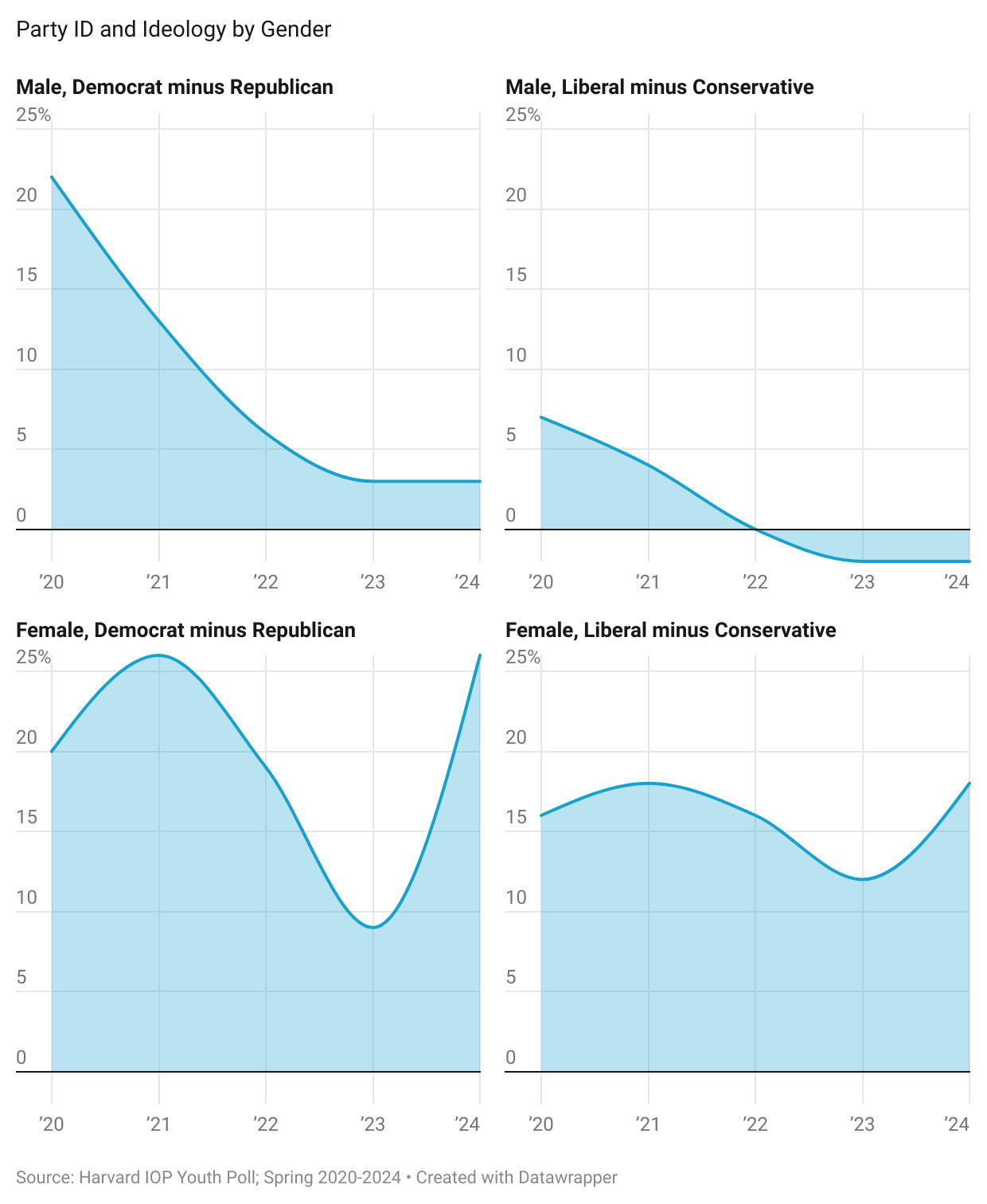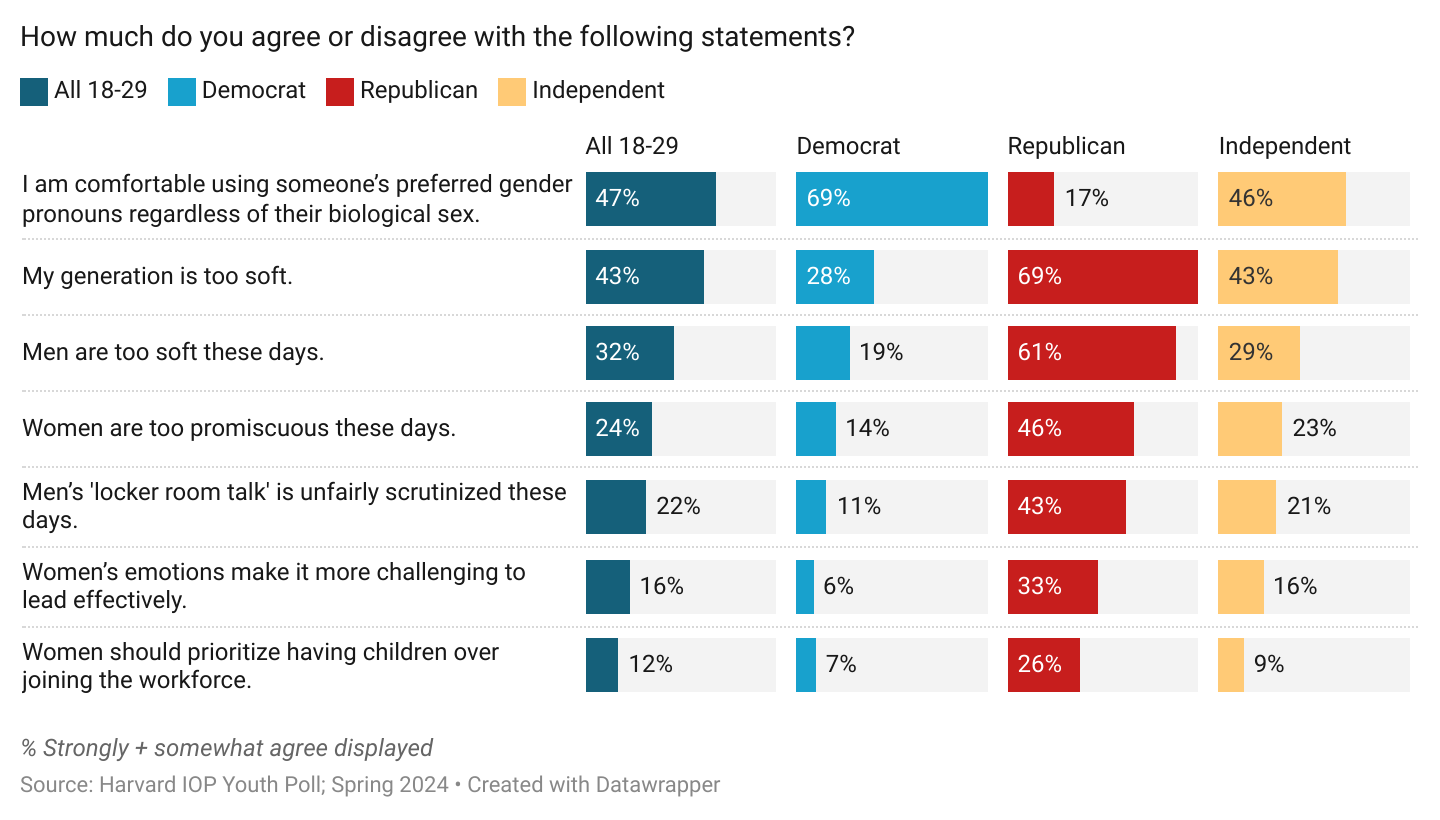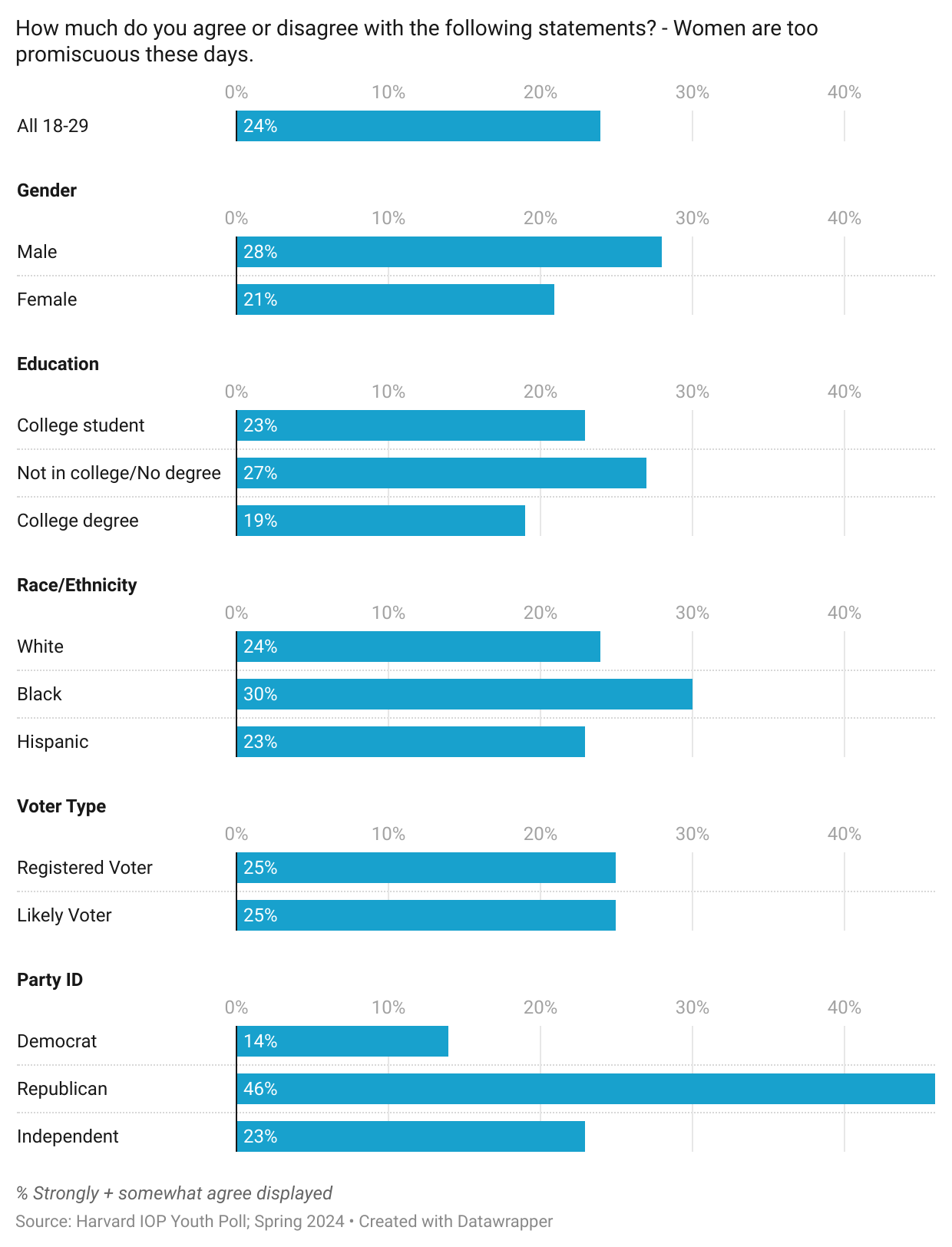This piece is published with the generous permission of John Della Volpe. To read more of his outstanding writing and analysis, visit JDVonGenZ+.
By John Della Volpe
I spent a few hours digging through previous Harvard Youth Poll datasets going back through 2012, preparing for a keynote talk at the New England Political Science Association last weekend. I was honestly surprised by what I found — and it made me reconsider whether I am thinking about the Biden/Trump campaign the right way. Looking at the registered voter grid (upper left) in the big blue chart below, two observations and questions came quickly to mind that I attempt to address today:
The data I share includes analysis of the horse race at this point relative to the last three presidential elections, and fresh data from the Harvard Youth Poll on the gender gap and the drivers of gender stereotypes like the “tradwife.”
I encourage you to spend time with the chart below; it says so much about the youth vote today.

In March 2012, the Harvard Youth Poll showed Barack Obama leading Mitt Romney by 13 points, 46% to 33%. Today, Biden leads Trump by the same 13-point margin — 50% to 37%. This year, though, there are fewer undecideds, and each of the presumptive nominees is four points stronger than their predecessors at this stage 12 years ago.
Biden’s youth vote margin may look modest relative to his lead four years ago, but perhaps that’s because today's young voters see Trump and the 2024 race from a different perspective than similar voters did in 2016 and 2020.
Among the newest cohort of young voters, 2024 is a more conventional contest than the previous two — especially among men, 18-24 year-olds, college students, Black and Hispanic voters.
While there’s no love for Trump among the 18-to-29-year-old set (remember, he polls at 37% among all registered or likely young voters), there are many first-time voters who look back at the pre-Covid Trump years through rose-tinted glasses and, therefore view him as less of a threat than others might. This doesn’t necessarily translate to widespread support, but young people have less urgency about defeating him than I picked up in the recent past.
In 2012, Obama (with Romney’s help — who could forget the 47% remark) defined Mitt Romney as out of touch with the average American, and he did it early before Romney had the time to define himself. In the final stretch of the campaign, Pew Research Center reported that Obama held significant double-digit leads over Romney on essential attributes such as:
While the economy will play a more important role than it did in the 2020 and 2022 elections, so will personal attributes like the ones above. Even though both Biden and Trump have been in the public eye for the last 50 years — young and first-time voters who may decide the election don’t know as much about Trump’s or Biden’s personal backgrounds, values, records, and visions as we think they do — or probably should.
I will be tracking attributes like these closely this spring and summer as markers of whether the 2024 campaign tracks 2012’s — when the Democratic incumbent clarified his record, successfully drew contrasts with his opponent over values and vision — and doubled his youth vote margin between spring and fall.
The big blue chart above also shows that among young male registered voters, President Biden is polling less well today than he did in 2020. Among women, he’s holding his own.
When we dig deeper into 2024 likely voters, the same patterns emerge. Compared with this stage in the 2020 campaign, Biden’s lead among women is nearly identical (was +35 in 2020), but his lead among likely male voters has been reduced from +26 in 2020 to +6 today.
While Democrats still hold a party ID advantage with younger males and females, as the chart below illustrates, Democrats have lost significant ground with young men between 2020 and 2023. In this post from last year, I charted similar defections from young Black and Hispanic Americans.

Over the last few years, we have noted an attitudinal shift on climate policy. In 2020, 60% of young men agreed that “government should do more to curb climate change, even at the expense of economic growth,” while today, agreement is down to 47%.
At the same time, young female opinion grew in favor of more government intervention in two (health insurance, poverty) of the three policy areas.
I don’t necessarily think that younger 18-to 24-year-old men today have fundamentally different views on the role of government than their slightly older counterparts. Still, I do think there’s a unique combination of factors influencing their opinions of politics, the parties, and, in turn, the two presidential candidates.
Beyond being in middle and early high school during the Obama to Trump whiplash years, there’s a growing sense among some young men that they are under attack, losing fundamental freedoms, and no one has their back. The rise of hyper-masculine online influencers, podcasters, and conspiracy theorists no doubt play a role in developing and reinforcing these views — I hear them often in my focus groups.
“Freedom is a great lie because we're truly not free. If we were truly free, we wouldn't have GPS tracking us, and we would be able to say what we want without people getting offended.” (White, Gen Z, Western PA)
Whether this political and cultural backlash is a trend or a post-COVID episode, it’s too soon to tell, but this campaign could well determine that answer.
Refer a friend
With increasing attention on culture war issues in media and politics, our Harvard Youth Poll students (HT Kritika) designed a new series of questions to benchmark youth opinions on gender norms, stereotypes, and prejudices.
Overall, we found that most youth do not subscribe to these gender-based stereotypes. Still, nevertheless, there are striking differences between how young Democrats, Republicans, and independents view the role of men and women in society.

Importantly, we find that political ideology, more than gender, education, race and ethnicity is more predictive of views related to gender norms in society today. The chart below is obvious.

Nothing can be taken for granted in 2024, specially when thinking about the youth vote.
Yes, Biden has a comfortable lead with young registered and likely voters—make no mistake about that. Whether it’s enough to secure the Battlegrounds, no one knows for sure. Biden’s growing popularity with seniors seems genuine, and this could well mask some weakness with youth. And while Zoomers carried a lot of the weight in the Zoomer-Boomer coalition, perhaps in 2024, Boomers will pick up more of their share.
Biden can return to the 60% share he and Obama held in 2012 and 2020. It will take an effort from the top down and the bottom up. It will require constant listening to what all young people are saying, understanding what they’re feeling, what they want, and an infrastructure that empowers other young people to feel comfortable expending some social capital on the President’s behalf—something too few are willing to do at this stage of the campaign.
I know the Biden campaign, and the White House, understands this at their core. But for Democrats to succeed, it’s going to take a much larger effort than what any one campaign can expend.











